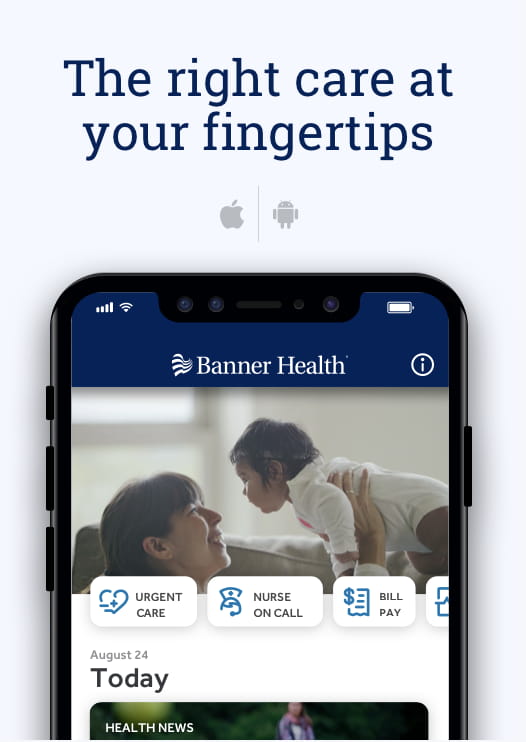We’ve all been there. Late-night fast-food runs, too many sodas, skipping veggies and choosing fries over fruit. Maybe it was a phase in your late teens and 20s or you’ve spent years eating this way, but now you’re wondering: Is it too late to turn things around?
The good news is: No, it’s not too late. According to Susan Welter, a registered dietitian with Banner Health, you’re never too old or young to start eating healthy.
“Recent data from health studies have found an association with increasing vegetable intake during midlife (your 40s) and a reduction in frailty later in life,” she said. “Providing your body with the nutrients it needs may help slow aging and improve overall health.”
While starting healthy eating habits early in life is ideal, making positive dietary changes at any age can still provide health benefits later in life.
Read on to learn more about the short- and long-term benefits of healthy eating and tips for getting started.
The immediate benefits of healthy eating
Once you start making healthier dietary choices, your body responds quickly. Within just a few days or weeks, you might notice:
- More energy: Junk food (processed and fried foods specifically) can make you feel sluggish but whole foods like fruits, vegetables, whole grains and lean proteins give you steady energy.
- Better digestion: Cutting back on greasy, processed foods can help keep things moving smoothly in the digestive tract, reducing bloating and stomach problems.
- Sharper focus: Your brain thrives on good nutrition. “Diets high in processed foods and sugars contribute to poor physical health and have been linked to impaired brain function,” Welter said. Foods rich in omega-3s (like salmon and walnuts) and antioxidants (like blueberries and spinach) support brain health, improving focus and memory.
- Improved sleep: Eating balanced meals can help you fall asleep faster and sleep more deeply.
- Clearer skin: Less sugar and processed foods can lead to fewer breakouts and acne.
Long-term benefits: A healthier future
While some damage from years of unhealthy eating can’t be completely undone, better nutrition can improve — or even reverse — many health problems. So what happens if you stick with healthy eating over time?
Heart health
A poor diet can lead to clogged arteries and high blood pressure (hypertension), increasing your risk for heart disease. But switching to a heart-healthy diet rich in fruits, vegetables, whole grains and healthy fats can help lower cholesterol and blood pressure, even if you start later in life.
Weight management
“Excess body weight increases the risk of chronic diseases such as diabetes, heart disease and certain cancers,” Welter said.
If years of unhealthy eating have led to weight gain, eating nutritious foods can help you lose weight and keep it off.
"Filling your plate two-thirds with vegetables, fruit, whole grains and beans and the remaining one-third with lean protein such as fish, poultry and lean meat helps maintain body weight and provides essential nutrients that protect health and promote longevity," Welter said.
Stronger immune system
Nutrient-rich foods like leafy greens, berries, nuts and seeds help strengthen your immune system, allowing you to fight off colds and infections.
“Your gut microbiome also plays a major role in immunity,” Welter said. “A healthy gut is important for nutrition absorption and a healthy immune system.”
Stronger bones and joints
Bone loss happens naturally with age but a diet rich in calcium (found in dairy, leafy greens and fortified foods) and vitamin D (found in salmon and fortified cereals) helps keep bones strong.
Mental well-being
“A nutrient-rich diet such as a Mediterranean-style diet contributes to a healthy body and brain, thus positively impacting mental well-being,” Welter said.
How to start eating healthy
Making the switch doesn’t have to be stressful or difficult. You don’t need to change everything overnight. Small steps can lead to big results.
1. Swap processed foods for whole foods: Instead of prepackaged snacks and meals, go for fresh fruit, veggies, nuts or yogurt. Instead of white bread, choose whole grain. These simple swaps add up.
2. Eat the rainbow: “Fruits, vegetables, whole grains, nuts/seeds and other plant-based foods are rich in vitamins, minerals and phytochemicals that lower the risk of age-related health conditions,” Welter said. “Focus on eating a rainbow of color each day.”
- Blue/Purple: Blueberries, plums, grapes, eggplant, purple figs
- Red/Pink: Beets, cherries, red apples, red peppers, strawberries, tomatoes
- Orange/Yellow: Carrots, mangoes, sweet potatoes, yellow peppers
- White: Bananas, cauliflower, garlic, mushrooms, onions
- Green: Broccoli, spinach, kale, avocado, green grapes
3. Focus on key nutrients: “Since nutrient absorption can decrease with age due to changes in the gut, it is even more important to optimize your diet,” Welter said. “Important vitamins and nutrients include vitamin D, B-12, nutrient-dense foods that can be easily digested like lean proteins and leafy greens and probiotic-rich foods like yogurt and kefir to promote gut health.”
4. Drink more water: Sugary drinks like soda and energy drinks can cause weight gain and blood sugar spikes. Water is the best way to stay hydrated and keep your body functioning well.
5. Read labels: Food labels help you make healthy choices. Read our article on understanding a product’s ingredients, serving size and nutritional content.
6. Experiment: Healthy eating doesn’t have to be boring. Try new recipes, experiment with different flavors and find nutritious foods you like.
Key takeaway: It’s never too late to start
No matter how long you’ve been eating unhealthy foods, it’s never too late to change. Start small, be consistent and enjoy the benefits of a healthier life.
If you have questions about your health or nutrition, speak with your health care provider or a registered dietitian.


